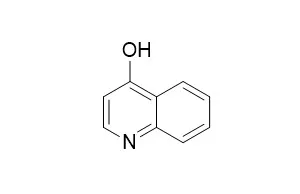| In vitro: |
| North-West University, 2006. | | Antioxidant properties of 4-hydroxyquinolines / Susan Elizabeth Neethling.[Reference: WebLink] | Oxygen, although vital for human survival, is the main source of reactive oxygen species, which can cause damage to essential biomolecules. Production of reactive oxygen species is linked to normal cellular processes; therefore eukaryotes have evolved a specific antioxidant system that curbs this toxic threat, protecting biomolecules against oxidative damage. Imbalance between the level of reactive oxygen species and antioxidants causes a deleterious condition referred to as oxidative stress. Oxidative stress has been implicated in the ageing process as well as the pathogenesis of various neurodegenerative disorders. It is thus crucial to identify compounds with antioxidative activity, which can counteract the oxidative attack and conditions such as Alzheimer's and Parkinson's diseases. Various hydroxyquinolines have been shown to protect biological systems against induced oxidative damage.
METHODS AND RESULTS:
Hence, with the aim to clarify the antioxidant properties, a series of 4-Hydroxyquinolines were selected as target compounds, synthesized and assayed. 4-Hydroxyquinolines with a nitro-, amino- and dibuthylamino-group in the 6 or 7 positions respectively were synthesized according to the Gould-Jacobs reaction followed by a number of transformation reactions and characterized by means of physical data. The antioxidative properties of the compounds were assayed in terms of: the oxygen radical absorbance capacity, the ability to reduce free chelatable iron, which was proven to play an active role in producing the highly toxic hydroxyl anion, the ability to scavenge superoxide anions and the ability to reduce lipid peroxidation. Results obtained in this study indicate that the 4-Hydroxyquinolines have antioxidative activity as it was shown to scavenge induced superoxide and peroxyl radicals, reduce free chelatable iron and inhibit induced lipid peroxidation. The nitro-4-Hydroxyquinolines were the best scavengers of superoxide anions. However, the amino-4- hydroxyquinolines, especially with the amino group present in the 6 position, have the most promising potential for antioxidative activity. All the compounds tested have the ability to scavenge induced peroxyl radicals. Compounds containing substituents in the 6 position showed more oxygen radical absorbance capacity than the 7-isomers, as well as significantly more iron reducing power. The amino compounds had more activity compared to the other compounds, and furthermore, 6-amino-4-Hydroxyquinoline showed more radical absorbance capacity as well as ferric reducing power than the rest of the compounds. All the test compounds significantly curbed the lipid peroxidation induced in vitro by 1mM KCN in a dose dependent manner. The compounds substituted in the 6 position have more activity and the amino-4-Hydroxyquinolines offered the most protection in vitro. In accordance to the in vitro studies, 6-amino- and 6-dibuthylamino-4-Hydroxyquinolines reduced lipid peroxidation in vivo, induced intrastriatally with MPP+. The increase in superoxide level induced by 1mM KCN as well as MPP+, in vitro and in vivo respectively, was significantly curbed by all the test compounds. In vitro, 7-nitro-4- hydroxyquinoline showed to be the best scavenger of superoxide anions, as it was the only compound able to reduce the increased level of superoxide anions in a dosedependent manner to a level below that of the control. In contrast to the in vitro study, the dibuthylamino-4-Hydroxyquinolines offer the most protection in vivo. Because intraperitoneal treatment with 4-Hydroxyquinolines reduced the level of superoxide anion generation and lipid peroxidation induced intrastriatally with MPP+, it can be assumed that these compounds crossed the blood brain barrier.
CONCLUSIONS:
From this study it is possible to conclude that 4-Hydroxyquinolines exert various antioxidative properties and may thus be used in the development of antioxidant strategies against neurodegenerative diseases associated with oxidative stress. |
|






 Cell. 2018 Jan 11;172(1-2):249-261.e12. doi: 10.1016/j.cell.2017.12.019.IF=36.216(2019)
Cell. 2018 Jan 11;172(1-2):249-261.e12. doi: 10.1016/j.cell.2017.12.019.IF=36.216(2019) Cell Metab. 2020 Mar 3;31(3):534-548.e5. doi: 10.1016/j.cmet.2020.01.002.IF=22.415(2019)
Cell Metab. 2020 Mar 3;31(3):534-548.e5. doi: 10.1016/j.cmet.2020.01.002.IF=22.415(2019) Mol Cell. 2017 Nov 16;68(4):673-685.e6. doi: 10.1016/j.molcel.2017.10.022.IF=14.548(2019)
Mol Cell. 2017 Nov 16;68(4):673-685.e6. doi: 10.1016/j.molcel.2017.10.022.IF=14.548(2019)